In early January, Robert traveled from South Carolina to visit the Burke’s extensive paleontology collection after receiving a Burke Museum vertebrate paleontology study grant. The Pacific Northwest has some of the best fossil records of early pinnipeds ranging from 30 to 7 million years ago, and the Burke is home to many of these fossils.
The oldest pinniped fossils are generally small, otter-sized seals known as Enaliarctos. Thought to have given rise to all later groups of pinnipeds—receiving the nickname “Grandfather seals.” Studying this group has exciting potential for better understanding how, when and why they evolved.
“One of the specimens I am studying is a surprisingly young (geologically speaking) record of Enaliarctos,” he said. “It consists of a small slab with nice mandibles and a scattering of vertebrae.” The fossil was found in the Astoria Formation, a 16 million-year-old site along the coast of Oregon. Robert estimates that the specimen is perhaps 5-6 million years younger than previous published species of Enaliarctos.
“This fossil indicates that the most primitive pinnipeds survived much longer than previously thought,” he said, but “it is unclear whether it is a new species or not.”
On a much larger scale, Robert is also studying a large, sea lion-like pinniped (Allodesmus) in the Burke’s collection. These large-bodied creatures lived 23 to 15 million years ago and were comparable to the size of modern Steller sea lions. They were deep-diving seals—hence their enormous eye sockets—and are extinct today.
“The second specimen I’m studying is a partial skeleton from Grays Harbor, Washington, of the genus Allodesmus,” he said.
A “spectacular fossil” according to Robert, it includes a skull with articulated jawbones, two-thirds of the spine and much of the ribcage. “This specimen represents the most recent fossil record of Allodesmus and extends the range from about 15 million to 9 million years.”
“The common theme here is that we do not understand why—or when—either went extinct,” Robert said. “Both of these fossils will inform us about the late survival, and ultimately, the extinction of each group of seals.”
See more fossils in the Vertebrate Paleontology collection or learn more about the Vertebrate Paleontology Collection study grant.



